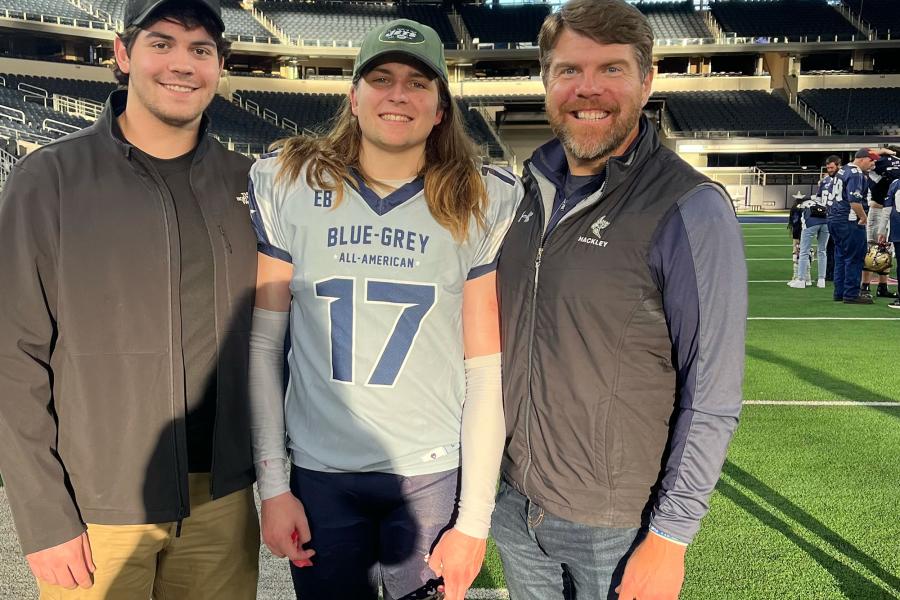Carter Hogg remembers the scary football hits. There was the time in middle school when he flew into the air and landed on the back of his head. Or the plays where he's gone in to make a tackle with his shoulder, only to have his opponent unexpectedly move, connecting instead with his helmet.
"Unfortunately, that's just the nature of the sport," says Hogg, a Johns Hopkins sophomore studying economics and a defensive back for the Blue Jays football team. "Sometimes it can't be avoided."
But the severity of the sport hit him anew when his older brother, FJ, suffered a career-ending hit as a linebacker for Washington and Lee University in the 2022 conference championship game. When the game was over, FJ couldn't remember playing.

Image credit: Courtesy of Carter Hogg
"He took a hit to the side of the head, just filling a gap on a normal run play," Hogg says. "It was really difficult seeing him go through not only the immediate aftermath of that but basically a two-year recovery period for him to just get back to where he was before that hit."
Shortly afterward, Hogg started researching concussions and ways to prevent them. His idea: a piece of protective equipment that could be worn under the helmet that would effectively reduce the risk of concussion without interfering with athlete mobility. G8RSkin, a balaclava-type garment meant to be worn under the helmet, was launched in 2023.
Concussions, a type of traumatic brain injury, occur when a person experiences a blow to the head, causing the brain to bounce around inside the cranial cavity, damaging brain cells or inducing swelling. Repeated trauma to the brain can lead to chronic traumatic encephalopathy, a neurodegenerative disease that progresses over time.
Helmets are crucial in preventing severe brain injuries, skull fractures, and facial injuries. The hard outer shell and foam inner of the helmet dissipate some of the force, but they are unable to stop all movement of the brain inside the skull.
G8RSkin works by redistributing the energy of collisions to stabilize the neck and reduce the rotational forces on the head. Initial studies conducted at Virginia Tech's Helmet Lab found that the product reduced the risk of concussion by 59%. Further testing is ongoing.
"It's essentially a flexible neck brace," Hogg says. "It's not going to restrict the movement of the player whatsoever during normal play. But when you do take that hit, it actively hardens, and in doing so resists the skull's movement so that the acceleration of the head itself is reduced drastically."
Hogg wouldn't comment on the proprietary material used to create G8RSkin—a material flexible enough to move with the athlete but able to toughen on impact. However, it's not an entirely new concept in the realm of materials science. Engineers who design bulletproof vests and military body armor have been working with a class of polymers whose molecules come together rather than disperse when agitated.
Hogg and some of his teammates have been testing G8RSkin on the gridiron this season, with a notable difference.
Also see
"Having taken hits like that before, I've gotten up very slowly. I've taken several seconds to get my bearings," Hogg says. "But this time I took the hit—and it wasn't pleasant—but I was able to pop up immediately. I felt completely fine."
The Blue Jays coaching staff have taken notice of Hogg's entrepreneurial spirit. "I think he is going to be extremely successful," says assistant football coach B.J. Hill. "To already have invented something that could be so impactful to the game of football while playing and in school says a lot about his determination and his work ethic."
Since launching in March 2023, parent company G8RTech has brought on to its advisory board a medical advisory committee and industry experts including Jay Brunetti, director of equipment operations for the San Francisco 49ers.
Hogg plans to expand G8RTech to innovate in other areas of sports protective equipment, including hockey equipment, mouth guards, and cleats. He hopes to make sports safer without asking athletes to compromise on their performance.
Posted in Athletics
Tagged football, materials science, entrepreneurship, traumatic brain injury









